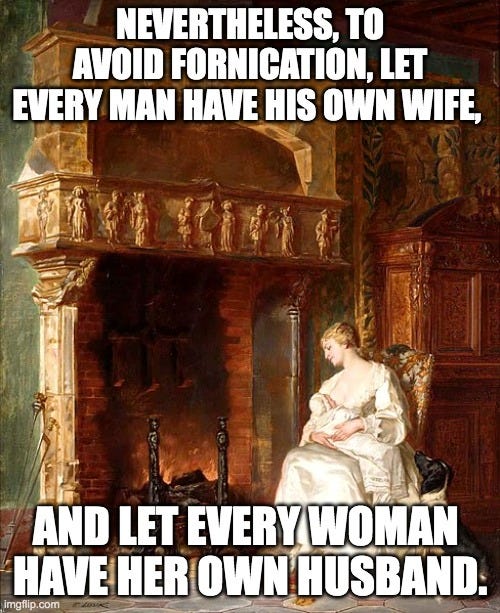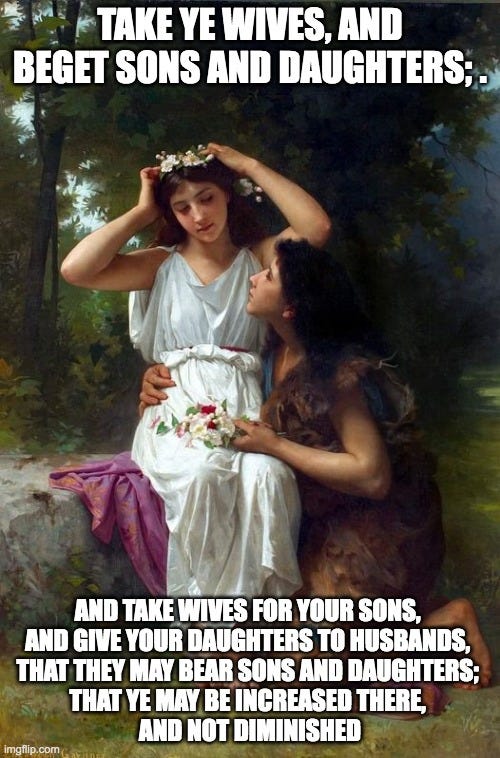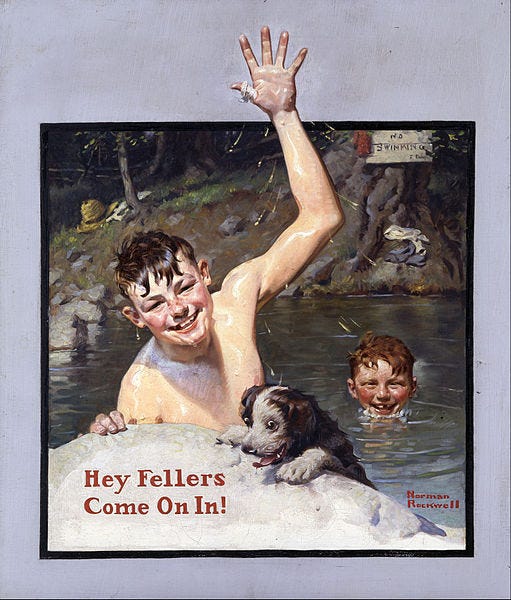One of the most annoying things to happen in a debate discussion is to find out that two or more of the participants have been using different definitions for the same word or words. Which tends to mean that they disagree even more than it seemed in the beginning, or that they actually agreed from the first.
I believe that it is helpful, when discussing any concept, to have a fixed definition, an ideal, and a view of the actual practice… and to realise that all three of these are different. The player who ‘plays baseball’ will almost certainly not be the ideal ‘baseball player’, and the rules of the game hardly begin to cover everything about it.
So to begin my discussion I would like to propose a ‘definition’ of monogamy that I am using… for the purpose of saying that monogamy is dying. I am not proposing to define the historical ideal or monogamy, still less the current practice of ‘monogamy’ in the modern west.
The Definition of Monogamy
For the purposes of this discussion alone I am proposing the definition of monogamy as: “The social practice of having only one sexual partner for life.”
Now, before you throw rotten tomatoes at me, I realise that what I am actually defining would be closer to ‘Mon-amory’. But since we are going to be contrasting monogamy with polyamory, one of the two definitions has to change in order for them to contrast1. And since, as I will argue, polygamy as traditionally understood and idealised is itself a contradiction to modern ideas of ‘polyamory’, we’re going to have to morph the definition of ‘monogamy’ to fit the discussion.
Thus I am not speaking of any legal relationship. The couple may or may not be ‘legally married’. The government, church, and wider society may or may not recognise or approve their relationship. But it is a sexual relationship, and is limited to the two of them, all of their life. This is what I am defining as the core ‘definition’ of the monogamy I am discussing.
Which differs both from the ‘idea’ and the ‘real’… the moral vision and the practical out-workings. The idealised couple is ‘in love’, and does have recognition from the wider society. (And the husband brings the wife roses, and she makes him a sandwich while he watches football, and all of their sex is awesome and when they are both fully in the mood…) The practical couple may be married after a death of a previous sexual partner, and the relationship may end in divorce, not death.
But as I propose it both the ideal and the practical are in tension with the core definition. The one pointing beyond, the other pointing beneath.
The Definition of Polyamory
Which brings me to the definition of ‘polyamory’. I am going to propose, “The social practice of having more than one sexual partner for life.” Notice what I did there. By only having the definitions differ in one area, this makes it easy for us to divide relationships and practices quickly and accurately.
Monogamy: “The social practice of having only one sexual partner for life.”2
Polyamory: “The social practice of having more than one sexual partner for life.”3
But, obviously, this means that there are a large number of relationships that will bear a resemblance to both. Polygamy, for example, shares a large number of traits with monogamy4… but it technically (for one spouse) polyamory. Indeed all of the exceptions to monogamy fall into ‘polyamory’, but many of them are opposed to the ‘ideal’ of polyamory outright.
So let me quickly add that the ‘ideal’ of polyamory is that the sexual relationships be multiple. Someone who wishes that they were able to have one, faithful sexual relationship all of their life is not promoting or following the ‘ideal’ of polyamory, however many sexual partners they actually have.
There are practical aspects of polyamory that make a tremendous difference in what ‘flavour’ of polyamory is being considered. When one thinks of a ‘line marriage’, for example, ideas of fidelity are present… just present in a group instead of two people. Which would contrast it with ‘open marriage’. Is the sexual activity scheduled? Or free floating?
Purposes and Principles of Monogamy
In looking at the modern death of monogamy we need to examine not just the definition of monogamy, but its purposes and principles. To examine the ‘idea’ of monogamy through the lens of what its promoters are trying to, ummm, promote.
Children
From the beginning of time one of, if not the, primary goals of marriage, and specifically monogamy has been the production and raising of children. Many successful children.
Sexual Faithfulness and Jealousy
You read that right. In monogamy not only is sexual faithfulness a goal, but so is jealousy. Not in the sense of making your spouse jealous, but in being glad that your spouse would be jealous if he caught you in a compromising position. Indeed in many societies, and more stories, the husband, at least, who catches another man with his wife might justifiably kill him. And be praised by the society.
Certainty of parentage
A combination of the two results in the goal of the certainty of parentage. US law has traditionally held it that, absent other evidence, the father of a child is presumed to be the husband of the wife. It is a goal in monogamy that every child be certain of their parentage
Till death do us part
In monogamy the goal is that the relationship last until the death of one of the partners.
Sexual access
Monogamy has a goal that both spouses will always have sexual access.
Common Law
Monogamy does not rely on, or idealise, the role of the church or the state in marriage. Historically a couple who started having sex would be called upon to ‘regularise’ their relationship… ie the relationship already existed, but needed to be recognised by the community. Monogamy can exist on a desert island.
Historical Exceptions to Monogamy
In any society that promotes monogamy, exceptions always exist in the practice. These exceptions are always in tension with the underlying definition and ideal, however. No one ever says, “Oh, he was so much more monogamous because he had mistresses.”
Death and Divorce
Monogamous societies have always had to deal with death and divorce. Most, but not all (see the issues of widows in historical India), have allowed for re-marriage after death or divorce, although typically not casually or immediately.
Polygamy
Polygamy is probably the longest running and most successful competitor to monogamy. However in many ways it is not a competitor. Polygamy usually exists in a monogamous culture, and is seen as an exception for the rich and powerful. It is seen as ‘monogamy +’. The ruler of a harem is not ‘polyamorous’, still less are his wives. They are faithful… but he has several wives. They are not a group for sexual purposes.
Many of the underlying ideals of polygamy and monogamy are the same… sexual faithfulness, children, known parentage… although they might be slightly modified. Thus the polygamous husband has sexual access, the wife not as much. The husband is considered ‘faithful’ even when he has sex with a different wife, etc.
Concubinage
One common feature of polygamy is the existence of a second class wife, or concubine. Most polygamous societies seemed to have some sort of concubinage. Again, they are not a group for sexual purposes. And usually many of the ideals are the same as for polygamy. Often it is desired that she produce children, they are acknowledged, etc.
Mistresses
In a society where polygamy is illegal, a man might have a mistress instead. She is expected to be faithful to him… not to share her favours with others… but was paid or at least lodged and given gifts.
Unlike polygamy, in a society that accepts mistresses many of the ideals of monogamy are missing. She is not there to provide children, the father may not acknolwedge the children.
Prostitution
Prostitution was the lowest class of ‘second wife’. In most ostensibly monogamous societies they came from the lower class, or were ‘fallen women’… who may have started higher class but through immoral choices or financial ruin were left ‘on the streets’.
A prostitute typically had several clients, and was not expected to remain faithful to one man for any length of time. Indeed a prostitute doesn’t fulfill any of the ideals of monogamy.
Pedastry
I would not say that a society which openly acknowledges pedastry is monogamous. Some societies have had parts of their society holding many monogamous goals while so doing, but it is fundamentally in contradiction to monogamy.
Different for married and unmarried
In many societies these exceptions were different, or treated differently, for married vs unmarried men and women. Thus an unmarried woman might become a mistress, but it would be much more scandalous if she were married. The unmarried man might use prostitutes and it be frowned upon, but the married man would be in a scandal.
Different for male and female, rich and poor
Historically monogamy has treated men and women very differently in the area of ‘exceptions’. For a man to have a mistress was immoral but forgiveable, a woman who was a mistress was ‘fallen’. If she was accepted in ‘polite society’ it was purely on the strength of her current relationship.
The rules could also be different for the rich and the poor. A Kennedy might get away with having mistresses, a Smith or a Jones not so much. Even for women. The daughter of a noble could be the mistress of a king and still be ‘gentle’, but the mistress of a tradesman… not so much.
Conclusion
So what I haven’t addressed in this article is the thesis: the death of monogamy. This article is meant to lay the groundwork. To give us measurements to look back and the last hundred years or so and see ways in which the monogamous assumptions of our society has crumbled. To see that even the historic exceptions to monogamy have been far surpassed nowadays.
This is not meant to be the last post on the subject, but the first post.
Introduction
This post comes in reaction to an exchange that I had with
in this threadwhere I insisted that we needed to keep the definition of monogamy fixed, in order to have any reasonable conversation on the subject. We both agreed that our culture has changed over the years and I proposed a letter exchange on the subject ‘The Death of Monogamy’. This is the result.
Pragmatic Caveat
For ordinary purposes we can use definitions that fit actual practice. But there are times, as here, when we cannot do so. The danger when you use a changeable definition and apply it to a historical or philosophical study, is that you can end up defining the discussion out of existence.
Let us say that we begin with ‘A’. And ‘A’ exists for a while, but then people begin doing ‘A and B’, or both ‘A and B’. And then, a couple of years later, they are doing ‘A and B and C’. And then, a few years after that, you notice that most of them are doing ‘B and C’ and very few doing A. Add in a few more generations and you are using the same word to refer to people doing ‘F and G’ that you originally applied to people doing ‘A’. So even though no one is doing ‘A’, you are still using that word. There might even have been some people doing ‘F and G’ back when you started studying ‘A’!!
This would make any historical question of ‘how many people are doing ‘A’’ ridiculous. Only if you carefully distinguish between A, B, C, etc. can you make a valid historical study.
Hyper-Modern Caveat
For the hyper-modern reader I should explain that for the purposes of monogamy and polygamy the sexual relationship mentioned is and can only be that of a man and a woman. By ‘man’ is meant a human person with XY chromosomes who was born with, and still possesses, a penis, testicles, scrotum. By ‘woman’ is meant a human person was born with and still possesses a vagina.
Thus even if two men have been each other’s unique sexual partner all of their lives, they are in no sense monogamous. Nor can two men and a woman be ‘polygamous’.
Thank you for reading Von’s Substack. I would love it if you commented! I love hearing from readers, especially critical comments. I would love to start more letter exchanges, so if there’s a subject you’re interested in, get writing and tag me!
Being ‘restacked’ and mentioned in ‘notes’ is very important for lesser-known stacks so… feel free! I’m semi-retired and write as a ministry (and for fun) so you don’t need to feel guilty you aren’t paying for anything, but if you enjoy my writing (even if you dramatically disagree with it), then restack, please! Or mention me in one of your own posts.
If I don’t write you back it is almost certain that I didn’t see it, so please feel free to comment and link to your post. Or if you just think I would be interested in your post!
If you get lost, check out my ‘Table of Contents’ which I try to keep up to date.
Thanks again, God Bless, Soli Deo gloria,
Von
Links
Halfway House
Perhaps it is just the kind of podcasts I listen to and articles I read, but an amazing number of ‘liberals mugged by reality’ seem to be whining about our society’s failure to stop at a halfway house, culturally speaking. On a fantastic number of issues, an amazing number of groups seem to be saying, “Why didn’t we stop?”
To be clear, if ‘monogamy’ merely meant ‘having one legal spouse’, then it would be fully possible for someone to be monogamous and polyamorous. A man with one legal wife and three other ‘wives’ whose relationship was not acknowledged by the state. A group of legally married ‘swinging couples’ who met every weekend to swap wives would still be ‘monogamous’ while being fully ‘polyamorous’. The ‘5 to 7’ relationships. The salesman with mistresses in each town.
See the section ‘A Hyper-Modern Caveat’ for more definition on ‘sexual partner’.
I realised, a bit belatedly, that the term ‘for life’ could be a bit confusing. The ideal in monogamy is that a girl remains a virgin until she marries (not necessarily a legal relationship), and that sexual relationship continue until one of them dies. In polyamory the ‘ideal’ (or at least ‘idea’) is that men and women have multiple sexual relationships going on more or less at the same time, and that this continue throughout their life.
See (2) for an important similarity.












The Marxist goal which informs all this madness is their strong need to abstract the individual from the family. These - literally and proudly - Godless heathen want The State to be Mother and Father to everyone, the State above all. It is why all Communist countries reward children for snitching on their parents. This destruction of the bonds of trust between husband and wife is one more step towards that goal. Just look at subcommunities in the United States with high rates of children born out of wedlock and in single parent homes for how wonderfully this works out.
These people want to destroy the nation and the normative values of a productive society based on solid families. I am baffled as to what they think is going to take its place. Legions of pink haired tattooed assholes whining to one another about "intersectionality" instead of doing productive things like studying math and learning a useful trade? Sounds like Hell.
To me polyamory simply means a continual orgy for all intents. It makes no sense when it comes to progeny and who is the father. If there are 10 couples that swap around all the time, who is responsible for the children that come out of such a convoluted relationship? Everyone? Have DNA tests? It's just sexual "gratification" for all intents. And then what happens when the whole concept turns bi sexual and the women are doing things with the women and the men are doing things with each other and on and on. Geezzzz...save me from that situation! A lot of young folks simply do not want the burden of the state involved in their relationship and many don't want to have children for a number of reason, some that make sense and some that are totally selfish. OK, take care!